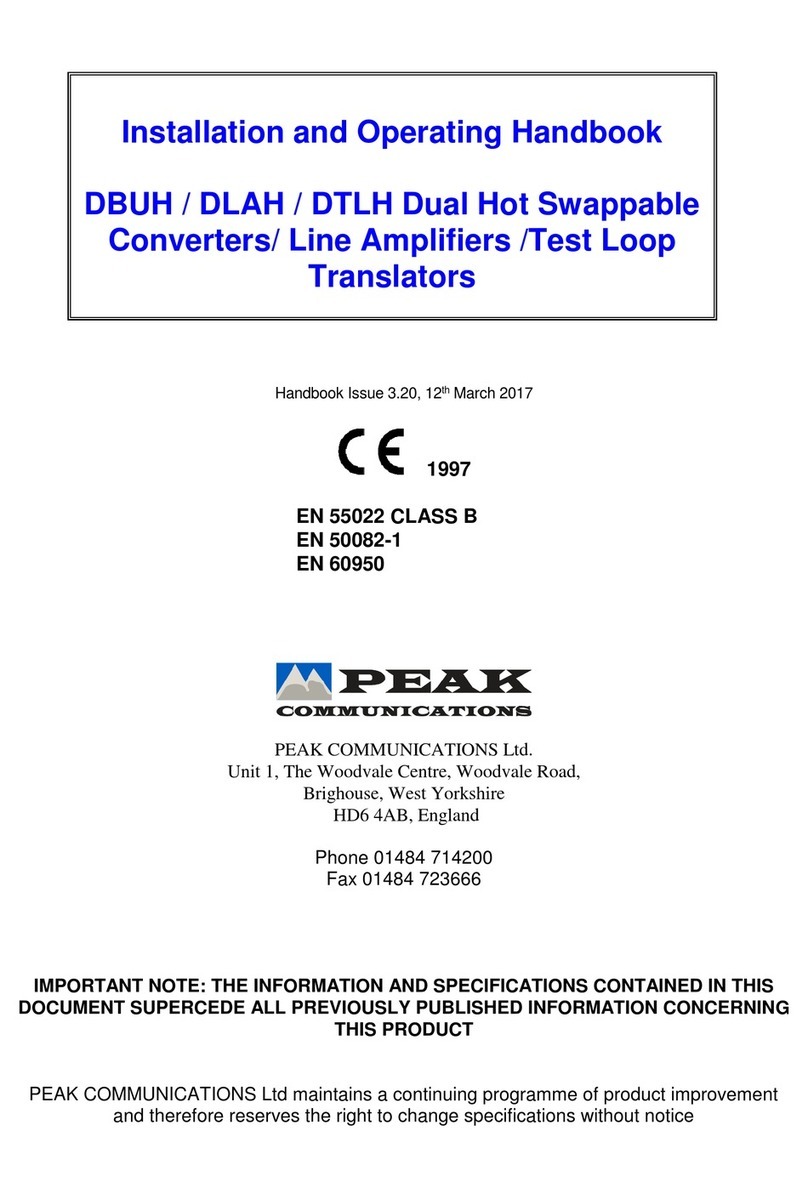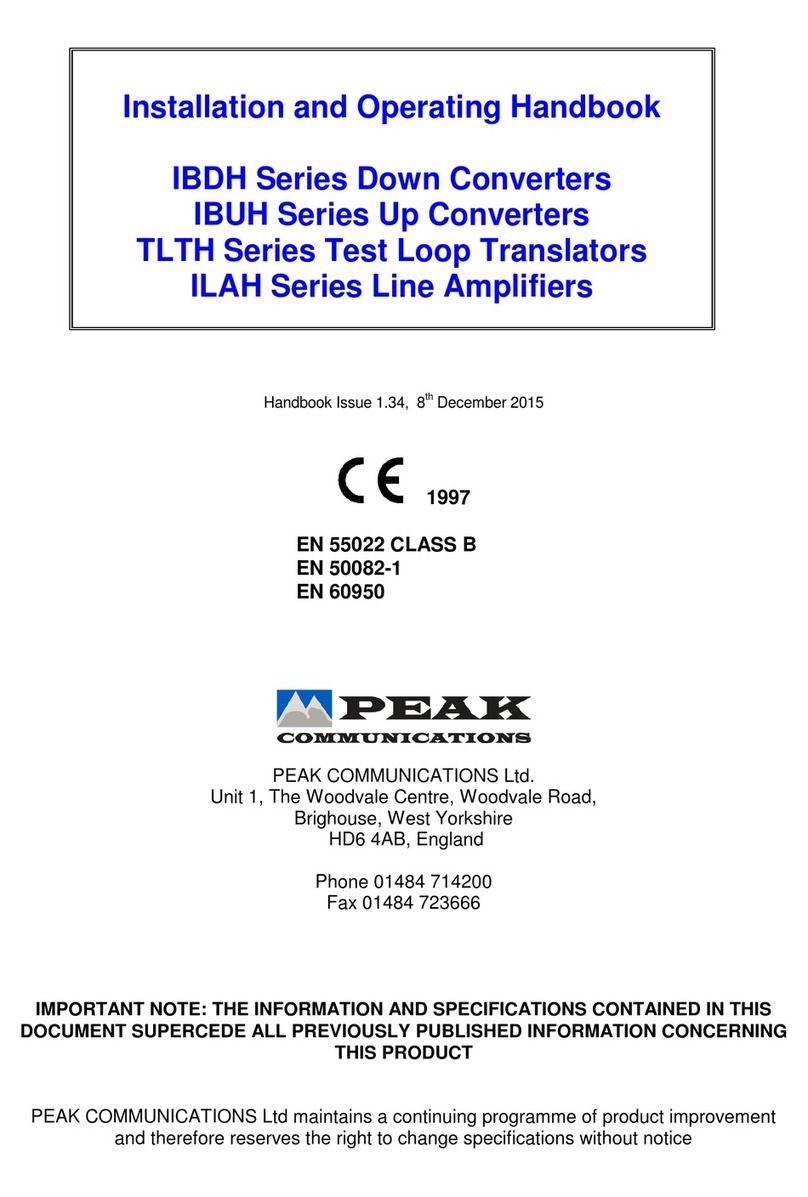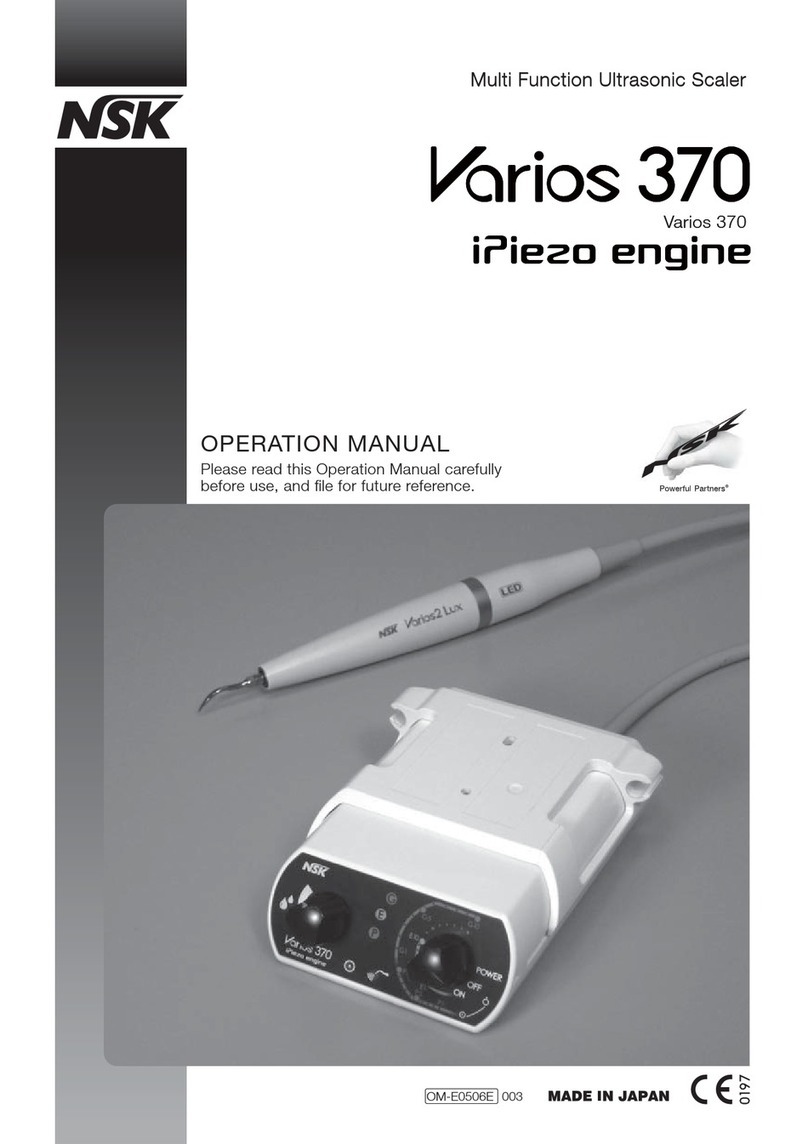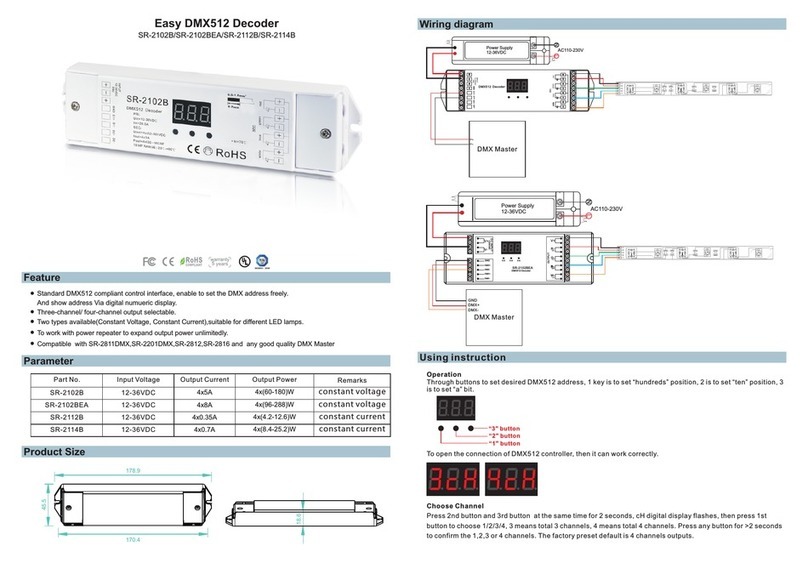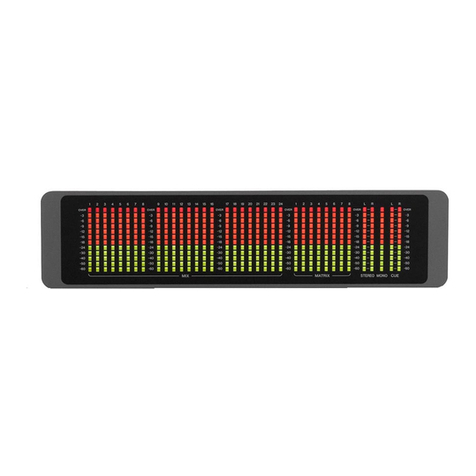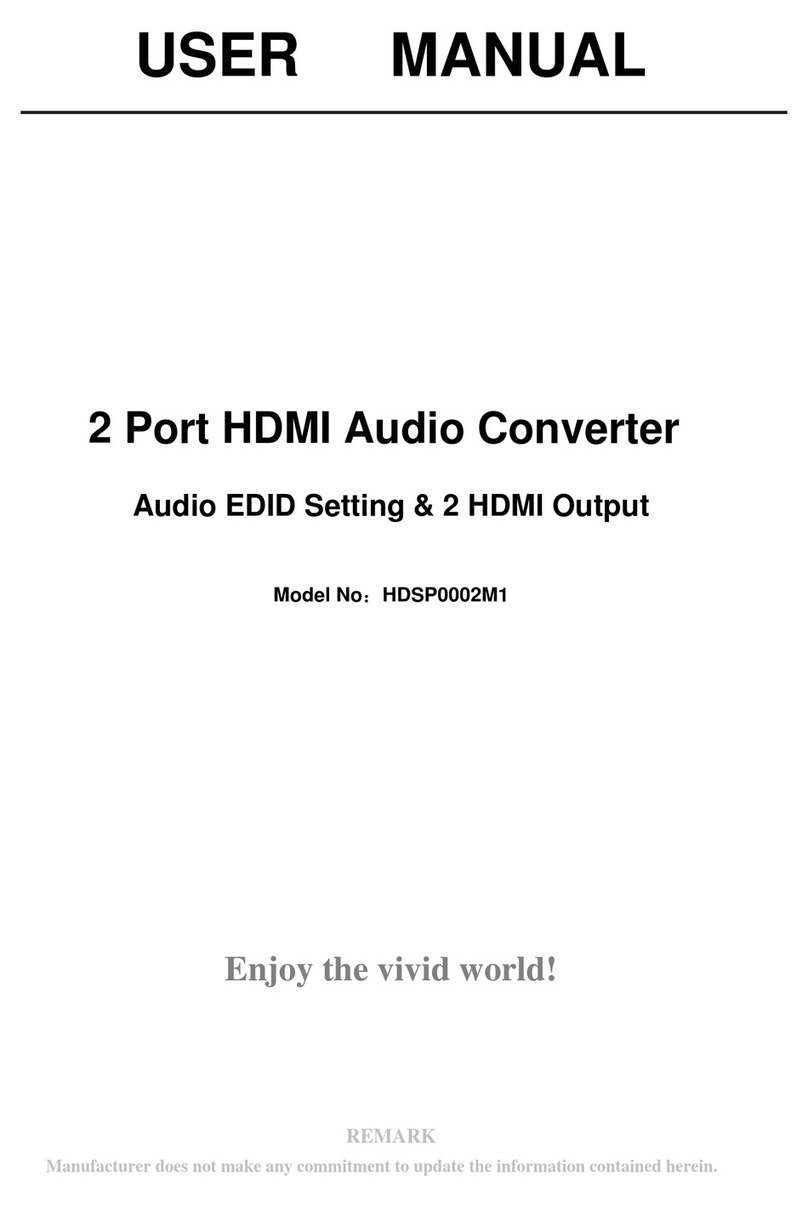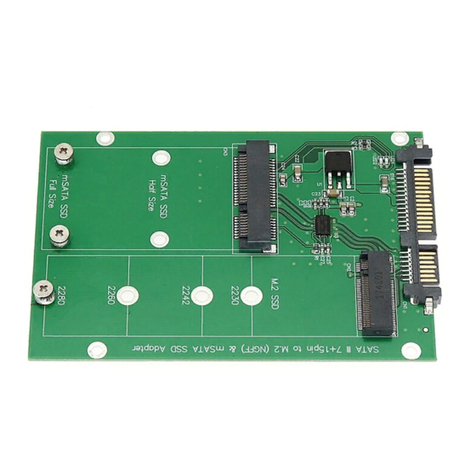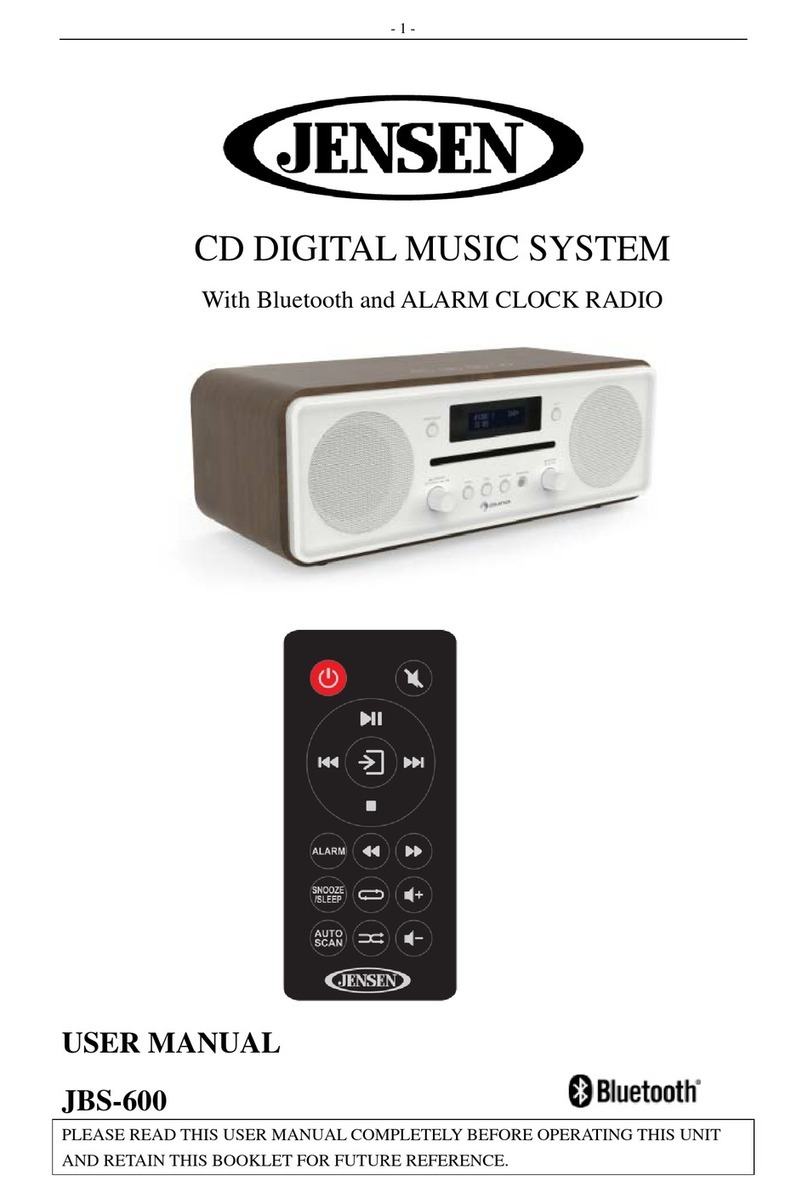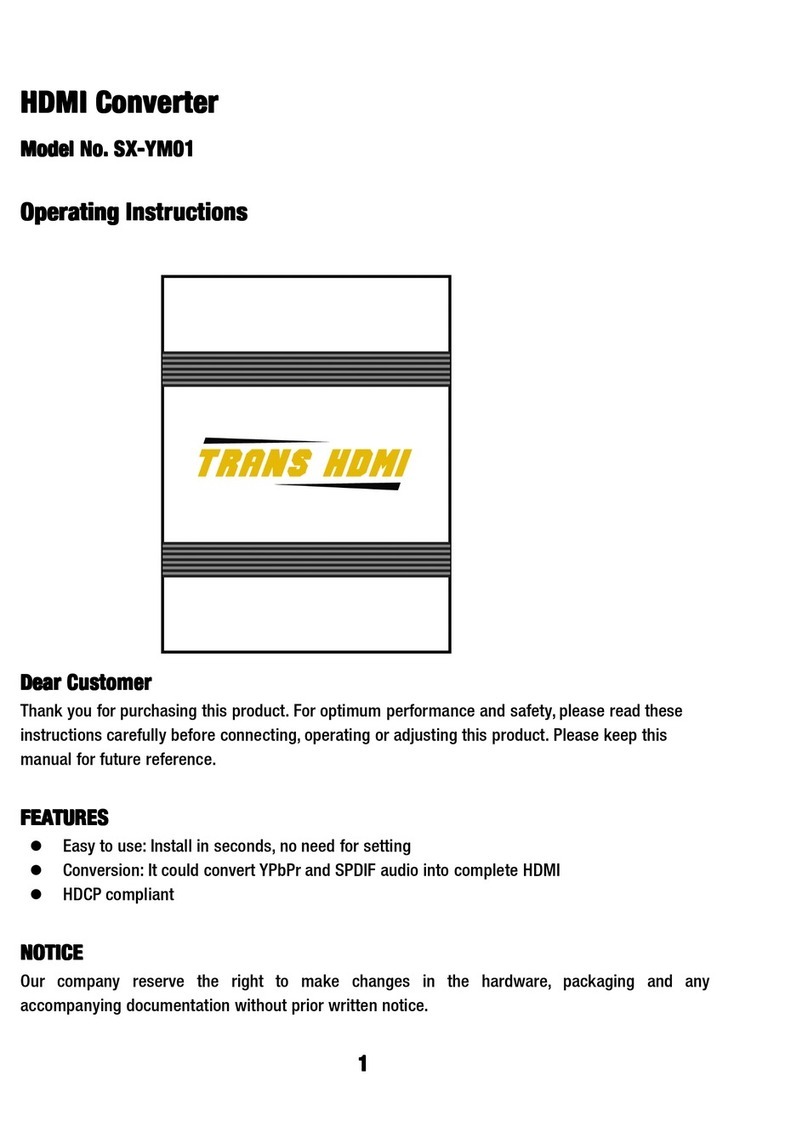PEAK COMMUNICATIONS P7001R User manual

Page 1 P7001R & P7002R Series Converters
Handbook Issue 1.03, 7th December 2015
PEAK COMMUNICATIONS Ltd.
Unit 1, The Woodvale Centre, Woodvale Road,
Brighouse, West Yorkshire
HD6 4AB, England
Phone +44 (0)1484 714200
Fax +44 (0)1484 723666
IMPORTANT NOTE: THE INFORMATION AND SPECIFICATIONS
CONTAINED IN THESE DOCUMENTS SUPERSEDE ALL PREVIOUSLY
PUBLISHED INFORMATION CONCERNING THESE PRODUCTS
Installation and Operating Handbook
P7001R & P7002R Converters

Page 2 P7001R & P7002R Series Converters
Table of Contents
PRODUCT COMPLIANCE........................................................................................................................... 3
Safety....................................................................................................................................................... 3
EMC.......................................................................................................................................................... 4
1. INTRODUCTION...................................................................................................................................... 4
1.1 General product overview................................................................................................................... 4
1.2 Functional description......................................................................................................................... 6
1.3 Review of P700XR series generic specification parameters.............................................................. 6
1.3.1 UpConverter IF Input.................................................................................................................... 6
1.3.2 UpConverter L / S / UHF-Band Output......................................................................................... 6
1.3.3 DownConverter IF Output ............................................................................................................ 6
1.3.4 DownConverter L / S / UHF-Band Input....................................................................................... 7
1.3.5 Frequency Resolution .................................................................................................................. 7
1.3.6 Phase noise (dBc/Hz)................................................................................................................... 7
1.3.7 Group delay.................................................................................................................................. 7
1.3.8 UpConverter Conversion Gain..................................................................................................... 7
1.3.9 DownConverter Conversion Gain................................................................................................. 7
1.3.10 Gain flatness .............................................................................................................................. 8
1.3.11 1dB Gain Compression Point..................................................................................................... 8
1.3.12 UpConverter Output spurious .................................................................................................... 8
1.3.13 Invert Spectrum.......................................................................................................................... 8
1.3.14 Auxiliary DC output..................................................................................................................... 8
1.3.15 10MHz reference output............................................................................................................. 9
1.3.16 Internal Reference frequency..................................................................................................... 9
1.4 Mechanical description ....................................................................................................................... 9
1.7 Fault philosophy................................................................................................................................ 14
2. INSTALLATION ..................................................................................................................................... 16
2.1 Care of Your Product........................................................................................................................ 16
2.1.1 Handling..................................................................................................................................... 16
2.1.2 Unpacking and Inspection.......................................................................................................... 16
2.1.3 Storage....................................................................................................................................... 16
2.2 Mechanical Installation Considerations............................................................................................. 16
2.2.1 Mounting..................................................................................................................................... 17
2.2.2 Cooling....................................................................................................................................... 17
2.3 Prime Power Supply & Connection................................................................................................... 17
2.3.1 Fuses.......................................................................................................................................... 17
2.3.2 Earthing...................................................................................................................................... 18
2.4 Other Interface Connections............................................................................................................. 18
2.4.1 L / S / UHF-Band Connections................................................................................................... 18
2.4.2 L / S / UHF-band Monitor Output Connections (optional on some units)................................... 18
2.4.3 IF Connections........................................................................................................................... 18
2.4.4 External Reference Input Connections ...................................................................................... 19
3. EQUIPMENT OPERATION.................................................................................................................... 19
4. REDUNDANCY...................................................................................................................................... 19
4.1 1 for 1 Redundancy (switched & passive)................................................................................. 19
4.2 1 for 2 Redundancy................................................................................................................... 20
4.3 1 for N Redundancy.................................................................................................................. 21
5. REMOTE CONTROL............................................................................................................................. 22
5.1 Ethernet remote control (Optional)............................................................................................ 35

Page 3 P7001R & P7002R Series Converters
CUSTOMER CARE
Contact the Peak Communications support department for:
Product operation, application support or training requests
Information for returning or upgrading a product
Comments or suggestions on any supplied literature
Contact Information
Peak Communications Ltd
Attention: Support Department
Unit 1, The Woodvale Centre
Woodvale Road
Brighouse
HD6 4AB
United Kingdom
Tel. +44 (0) 1484 714200
Fax +44 (0) 1484 723666
E-mail suppo[email protected].uk
You can also contact us via our website at www.peakcom.co.uk
To return a Peak Communications product for repair:
1. Contact the Peak Communications support department and request a
Return Material Authorisation (RMA) number.
2. You will be required to provide to our support representative the model
number, serial number and a detailed description of the problem.
3. To prevent any damage to the product during shipment we
recommend that the unit is returned in its original packaging or if this is
not available the packaging used must be of an equal standard.
4. Return the product back to Peak Communications and advise
shipment details to support representative for tracking purposes. (Any
shipping charges should be prepaid)
PRODUCT COMPLIANCE
Safety

Page 4 P7001R & P7002R Series Converters
To ensure safety of operator the P7000 series of converters have been designed
to comply with the following safety standard;
EN 60950: Safety of information technology equipment, including electrical
business machines.
Operation of the equipment in a non standard manner will invalidate compliance
to this standard.
The equipment MUST BE OPERATED WITH ITS LID ON AT ALL TIMES. If it is
necessary to remove the lid for any purpose then it is essential that the lid is
fitted back correctly before normal operation.
DANGEROUS VOLTAGES ARE PRESENT AROUND THE POWER SUPPLY
AND PRECAUTIONS MUST BE TAKEN.
EMC The P7000 Series of converters have been designed to comply with the following
standards;
Emissions: EN 55022 Class B; Limits and methods of measurement of
radio interference characteristics of Information Technology Equipment.
Immunity EN 50082 Part 1; Generic immunity standard, part 1: Domestic,
commercial and light industrial environment.
Damage to the keyboard membrane or mechanical damage to the chassis will
also invalidate compliance; please contact the factory under these
circumstances for advice on continued operation.
Interfaces to the P7000 Series of converters must be made with suitably
screened connectors and double screened coaxial cable. Data cables must be
double screened.
All 'D' type connectors must have grounding fingers on the plug shell to
guarantee continuous shielding. The back-shells must comply to the
requirements of VDE 0871 and FCC 20708, providing at least 40 dB of
attenuation from 30 MHz to 1 GHz.
Installations which do not comply with this requirement will invalidate the EMC
specifications.
1. INTRODUCTION
1.1 General product overview

Page 5 P7001R & P7002R Series Converters
This manual covers the installation and operation of the P7001R and P7002R Up
and Down frequency converters. A sample specification and review of generic
specification parameters is incorporated in this manual, but is not guaranteed to be
the latest specification or to represent all products covered by this manual, so
please visit our website www.peakcom.co.uk for exact up to date specifications of
the unit in question.
All P7000R series converters are housed in an IP66 diecast enclosure 290 x 230 x
95mm (11.4 x 9.1 x 3.7inch) and are designed to connect between a Modem IF,
and provide an L or S-Band interface as required. The units are especially suitable
for systems requiring an IBS and Eutelsat SMS compliant high stability low phase
noise frequency converter for both data and analogue TV signals.
The units are under constant development and new features may not be included
in this manual.
Models covered in this manual:-
P7001R L-Band to IF DownConverter
P7002R IF to L-Band UpConverter
The P7001R and P7002R units provide a high stability 10MHz reference signal and
22.5V DC power for both the transmit and receive paths to power an external Block
Up and Downconverter. The P7000R series of converters will interface with the
Peak CANBUS redundancy units for 1:1, 1:2 and 1:N systems (see RT1000R
RT2000R and RCU1800 data sheets)

Page 6 P7001R & P7002R Series Converters
1.2 Functional description
The P700XR series will UpConvert a 70 ±18MHz (optionally 140MHz ±36MHz)
signal to a frequency within the L-Band range of 950-1750 MHz or S-Band range of
2.025-2.120GHz) and will DownConvert signals within the L-Band range of 950-
2150MHz or S-Band range of 2.2-2.3GHz to 70 ±18MHz (optionally 140MHz
±36MHz).
Both transmit and receive paths feature two stage frequency conversion and can be
set to a frequency resolution of 1 Hz. The unit features a RS232/RS485 or optionally
Ethernet remote control function for control and configuration of the unit. The units
have built in 1:1 and 1:2 redundancy control.
The P700XR is fully software controlled; there are no links or switches used to
configure the unit. This enables all control and configuration to be programmed
remotely. All the configuration parameters are stored in non-volatile memory that will
retain data for a minimum of 25 years with no power applied.
1.3 Review of P700XR series generic specification parameters
This section is provided to show typical values and explain the parameters involved.
The specifications do vary between units and may change, so please refer to our
website www.peakcom.co.uk for the latest up to date specifications.
1.3.1 UpConverter IF Input
70 18 MHz or option 140 36MHz
If the converter is set to output a frequency of 1200MHz then the centre frequency at 70
MHz (or 140MHz) will convert to this frequency. If you change the input frequency
across the IF input band at 70MHz (using for example the modem frequency output
control) without changing the output frequency then the output will be correspondingly
lower/higher in frequency. If you input, for example 65MHz with the converter frequency
set to 1200MHz the output will actually be 1195MHz. At all times the bandwidth of the
signal should be calculated / measured so the 18MHz at 70MHz (or 38MHz at
140MHz) is not exceeded.
1.3.2 UpConverter L / S / UHF-Band Output
950-1750MHz (2025-2120MHz for S-Band, 390-450MHz for UHF-Band)
Centre frequency for a 70MHz (or 140MHz) input. A consideration of your signal
bandwidth should be made because at 950MHz the lowest available frequency is 950-
18MHz =932MHz, which means you could transmit out of band.
1.3.3 DownConverter IF Output
70 18MHz or option 140 36MHz
As above for an UpConverter output, if the converter is set to input a frequency of
1200MHz then the centre frequency at 1200MHz will convert exactly to 70MHz (or
140MHz). If you input a frequency not exactly at the input frequency then the output will
be similarly lower or higher by the same amount

Page 7 P7001R & P7002R Series Converters
1.3.4 DownConverter L / S / UHF-Band Input
950-2150MHz (2200-2300MHz for S-Band, 390-450MHz for UHF-Band) range of limit
of input.
1.3.5 Frequency Resolution
1 Hz Output frequency step size.
1.3.6 Phase noise (dBc/Hz)
-65dBc/Hz @ 10Hz; -75dBc/Hz @ 100Hz; -80dBc/Hz @ 1kHz; -85dBc/Hz @ 10kHz; -
95dBc/Hz @ 100kHz; -110dBc/Hz @ 1MHz. Typical depending on model
At 100Hz away from the carrier the average relative intensity of the carrier in CW mode
at that point is 75dB lower than the centre frequency
1.3.7 Group delay
Linear 0.025nS, Parabolic 0.015nS/MHz2, Ripple 1nS p-p.
The relative timing distortion imposed on a signal passing through the converter within
the 18MHz band at 70MHz. This is due mainly to the internal filters. The group delay
profile is described mathematically as follows
The linear function describes the straight line slope across the 36MHz range. At
0.025nS over 36MHz the slope across the pass band calculates to 0.025x36=0.9nS.
The parabolic function is a quadratic function and can be converted at any point to a
linear function by multiplying the specification parameter by the square of the frequency
offset. For example for a Parabolic specification of 0.015nS/MHz2at a frequency of
60MHz the offset is 10MHz (70-60). This can be expressed in the form of an actual
delay by calculating (70-60) squared x 0.015ns which is 100x0.015=1.5nS. This figure
is always positive and the corresponding frequency at 80MHz calculates in this
example to the same figure of 1.5nS. Note that the group delay is defined for a 70MHz
IF and the group delay for a 140MHz is considerably improved especially the parabolic
function.
The ripple parameter defines the limits of the balance of the group delay distortion after
the linear and parabolic functions have been subtracted. This distortion is not
necessarily a sinusoidal waveform and is important when considering high symbol rates
1.3.8 UpConverter Conversion Gain
Gain; +20dB ±1dB
Attenuation; 0-30dB, stepped 0.1dB
With maximum attenuation the Gain of the converter is set to -10dB (to lose 10dB
through the conversion process) or with minimum attenuation to +20dB (to gain 20dB).
The finite gain set is specified to be within 2dB of the setting and the step size is 0.1dB.
The tolerance of the step size is not specified but should not exceed 0.05dB per step.
1.3.9 DownConverter Conversion Gain
Gain; +30dB ±1dB
Attenuation; 0-30dB, stepped 0.1dB

Page 8 P7001R & P7002R Series Converters
The gain of the converter can be set to have no gain (0dB) at maximum attenuation or
a gain of 30dB at minimum attenuation. The finite gain set is specified to be within 2dB
of the setting and the step size is 0.1dB.
1.3.10 Gain flatness
±1.5dB full band, ±0.5dB, across any 36MHz in band
The slope and variation of power across the L/ S-Band should be within 2dB top to
bottom, but within 1dB across any 36MHz.
1.3.11 1dB Gain Compression Point
Output +10dBm, Input -10dBm
The 1dB compression point is a finite point in the power scale where a 1dB input only
gives 0.5dB increase in power. At a gain of +20dB the output stage of the unit will
compress before the input stage and conversely at gains of less than 20dB the input
stage will compress before the output stage. Note also the values specified are for total
composite power and not single carrier.
1.3.12 UpConverter Output spurious
<-60dBm (in band non-carrier related), <-60dBc (in band carrier related)
All converters generate spurious signals due to Local Oscillator leakage inside the unit
and possibly some mixing products of these oscillators. These signals are always
present to some degree and are not related to the carrier signal being present so are
specified as a maximum finite power in dBm and are always measured at full gain.
Other signals associated with the carrier are also specified but relative to the carrier
(dBc) and again measured at full gain. During manufacture only out of band signals in
the minimum /2 and maximum x2 range are considered. Note that these spurii will be
seen to change in finite value when gains other than full gain are selected due to
switching of internal attenuators.
A typical setup is to set a converter input power of -20dBm and an output of 0dBm.
Consideration of spurii should be made if the input power is significantly reduced as low
input power will give a worse spurious to signal ratio.
1.3.13 Invert Spectrum
In a conversion process if the Local oscillator used is of a higher frequency than the
Input frequency then the output will be spectrum inverted. This means that the High
Frequency side of an FM signal will come out at the Low Frequency side of the centre
frequency. To decode a signal the decoder must know whether the signal is inverted
and somewhere in the system there must be a mechanism to re-invert the signal.
A classical example is the 5.15GHz oscillator used in a C-Band LNB. To convert the 3.4
to 4.2GHz band to 950MHz to 1750MHz a 2.45GHz LO is the calculated frequency.
Unfortunately this 2.45GHz LO gives a problem due to twice the LO mixing with the
input to give an interfering signal (4.9-3.4=1.5). A 5.15GHz LO is therefore used to
avoid this problem and consequently the L-Band to 70MHz converter (P7001R) has to
have INVERT enabled to preserve the spectrum. It is not normal to transmit inverted.
1.3.14 Auxiliary DC output.

Page 9 P7001R & P7002R Series Converters
22.5 volts regulated @ 0.5 amp, software switchable.
This facility is used for driving an external L-Band to SHF BUC on an UpConverter and
a BDC/LNB/LNA on a DownConverter. This voltage is integrated with the L-Band signal
(along with the 10MHz, as appropriate). This voltage is generated by a regulator and
will pull down to zero without damage, however the internal fuse may be damaged if
this happens.
1.3.15 10MHz reference output.
0dBm nominal, software switchable.
This facility is used for stabilising the output frequency of an external BUC/BDC. This
signal is integrated with the L-Band signal. An outdoor BUC will drift in frequency due to
ambient temperature changes causing changes to the BUC locking crystal inside the
unit. Inside Peak BUC’s and BDC’s the facility is made to pick up the 10MHz locking
signal sent by the P7000 series and lock to the internal crystal. With the BUC locked to
the indoor unit, the stability of the BUC unit is as good as the internal P7000 crystal.
With very long cables caution should be taken not to attenuate the 10MHz (and DC) too
much.
1.3.16 Internal Reference frequency.
A stable internally generated reference frequency of 10 MHz, trimmed by software.
Uses a high grade OCXO at 10MHz.
Accepts an External reference input of either 5 or 10MHz to lock the internal reference
to a common ‘station clock’.
Typical standard stability (higher stability options available); <5x10-10 per second,
<5x10-9 per 12hrs, ageing <5x10-7 per year and temperature stability of <5x10-7 over 0
to +40deg.C.
1.4 Mechanical description
The P7001R/P7002R converters are housed in an outdoor mountable, waterproof
environmentally sealed die cast enclosure as shown below.

Page 10 P7001R & P7002R Series Converters
P7001R
Remote Mount
IF Downconverter

Page 11 P7001R & P7002R Series Converters
Operation
Remote control is available from the front face connections in RS232/RS485 or with
optional ethernet control. All internal oscillators are fed from a single internal reference,
which can also be locked to an externally provided 10MHz reference frequency to
ensure the system is stable and the changeover from one converter to another,
minimizes traffic interruption. Customer supplied DC at 24V to 36V is internally fused to
1 amp and internally re-regulated to supply required voltages to the RF and supervisory
circuitry. A form C summary alarm connection is available for monitoring the units unit
via an M&C system.
Power /
Alarms RF In Ethernet RF Out Redundancy
Status
1A MAX
FUSE: 20 x 5mm EXT Ref.
P7001R/P7002R connector panel
The P7001R/P7002R converters have the following connections:
FUSE Bulkhead mounting 20mm x 5mm 1Amp fuse removable by turning.
EXT REF TNC Female connector for 10MHz reference supply.
BREATHER Immersion proof breather.

Page 12 P7001R & P7002R Series Converters
POWER / ALARMS 16 Pin connector with connections as below. The cable used must
be rated for 1Amp continuous use.
Power /
Alarms
A
P
B
C
D
EF
L
K
I
H
G
M
N
O
R
Pin number
Function
Description
A
Gnd
Chassis Gnd
B
RS232 Rx
RS232 Communication Rx
C
RS232 Tx
RS232 Communication Tx
D
RS485 Y
RS485 Communication Tx +
E
RS485 Z
RS485 Communication Tx -
F
RS485 B
RS485 Communication Rx -
G
RS485 A
RS485 Communication Rx +
H
External Alarm
Active low TTL pulled high internally
I
N/A
K
N/A
L
External Mute
Active low TTL pulled high internally
M
Alarm N/C
N
Alarm Com
Form C dry contact summary alarm
O
Alarm N/O
P
Gnd
Chassis Gnd
R
DC Supply
24V DC to 36V DC supply
External Mute & Alarm are selected when not shorted to Gnd, these inputs can be set
to be ignored via the Web Interface if required.
RF IN N-Type Female connector, input at L-band range is 950 to
2150MHz.
ETHERNET Sealed RJ45 connector fitted, cover must remain in place to keep
IP rating when not in use
RF OUT N-Type Female connector, output in the range 70 MHz ± 18MHz

Page 13 P7001R & P7002R Series Converters
REDUNDANCY INTERFACE 8 pin connector with connection as below. The cable
used must be rated for 1Amp continuous use.
GND
N/C
2
8
3
7
5
1
6
4
Interface
Alarms
Pin number
Function
1
Can Bus Low
2
Gnd
3
Power A
4
Power B
5
Gnd
6
Can Bus High
7
Tellback A
8
Tellback B
STATUS Online indication, Green = online, Amber = offline, Red = alarm

Page 14 P7001R & P7002R Series Converters
1.7 Fault philosophy
Fault conditions are divided into two categories;
a)MAIN UNIT COMMON FAULTS; Faults with internal items that effect the
overall unit (Main power supply assembly etc).
b)DEVICE SPECIFIC FAULTS; Faults that are specific to the Up or
DownConverter assemblies. These can include external fault inputs.
Most faults as shown below activate the summary ALARM on the unit, this will force
a change-over if used in a normal redundant system.
The only fault that does not cause the unit to go into ALARM is the ‘External Mute’.
All faults shown below are reported the remote interface and turn the tri-colour fault
LED to red.
Green –No faults
Amber –Unit in standby
Red –Fault condition
The MUTED column shows if the output is muted when the ALARM is active.

Page 15 P7001R & P7002R Series Converters
MAIN UNIT COMMON FAULTS:
Fault Name
MUTED
SUMMARY ALARM
Primary DC Power Supply
No
Yes
Over/Under Temperature
No
Yes
External Reference Fault
Yes
Yes
Crystal Fault
Yes
Yes
Redundancy Coax Switch
Yes
Yes
DEVICE SPECIFIC FAULTS;
UPCONVERTER:
Fault Name
MUTED
SUMMARY ALARM
+3 VDC Power Supply
No
Yes
+5 VDC Power Supply
No
Yes
+15 VDC Power Supply
No
Yes
Primary DC Power Supply
No
Yes
1st LO Fault
Yes
Yes
2nd LO Fault
Yes
Yes
815MHz Fault
Yes
Yes
External Fault
No
Yes
External Mute
Yes
No
Internal Communications
No
Yes
DOWNCONVERTER:
Fault Name
MUTED
SUMMARY ALARM
+3 VDC Power Supply
No
Yes
+5 VDC Power Supply
No
Yes
+15 VDC Power Supply
No
Yes
Primary DC Power Supply
No
Yes
1st LO Fault
Yes
Yes
2nd LO Fault
Yes
Yes
External Fault
No
Yes
External Mute
Yes
No
Internal Communications
No
Yes

Page 16 P7001R & P7002R Series Converters
2. INSTALLATION
2.1 Care of Your Product
2.1.1 Handling
The shipping carton is qualified for transit of these products and has been used
successfully for many years. It will protect against shock and vibration encountered
during normal carrier transportation.
PLEASE RETAIN ALL PACKING MATERIALS, including the foam insets. Should the
unit need to be returned, return to the address on the front of the manual USING THE
ORIGINAL PACKING CARTON, unless it has been seriously damaged.
Avoid subjecting the packaged or unpackaged product to severe shocks.
2.1.2 Unpacking and Inspection
When the product is first received, the outer pack should be inspected for signs of
damage. If damage to the outer pack is evident, contact the Carrier immediately and
submit a damage report. The equipment should then be removed and inspected for
signs of damage, retaining all packing materials. Any visible signs of damage to the
equipment should be reported immediately to Peak Communications (electronic
photo’s of the pack and equipment can help with any subsequent insurance claims). If
the equipment appears undamaged, it should be tested for correct operation and
again any abnormalities reported to Peak Communications.
When first removing the product from its transit pack, take care to retain all
documentation and associated hardware. These products are typically provided with
the following items;
P700XR series product.
Operation Manual.
Test Results.
Spares Kit.
If you suspect that any item is missing, please contact Peak Communications
immediately.
2.1.3 Storage
Store the product in the normal horizontal orientation, in its outer carton until it is
required for use. Do not use the products to support the weight of other items whilst in
storage.
Storage temperature range is typically from -40°C to +80°C, avoid exceeding these
extremes otherwise damage may result.
Avoid exposing the packaged or unpackaged product to extremes of humidity or
moisture (including condensation). In the event that this does occur, the product
should be left at room temperature for in excess of 5 hours to dry naturally before
application of prime power.
2.2 Mechanical Installation Considerations

Page 17 P7001R & P7002R Series Converters
2.2.1 Mounting
The product can be mounted using the multiple mounting holes supplied on the
bracket. Alternatively the mounting brackets may be removed and the unit mounted
using the 4 hole on the base of the unit, hoever the correct length of screw must be
used to prevent damage to the unit
2.2.2 Cooling
Unit must be mounted in a position to minimise solar gain and provide cooling via the
mounting bracket.
2.3 Prime Power Supply & Connection
24VDC to 36VDC required to power these units.
2.3.1 Fuses
The equipment is provided with short circuit fuse protection. The fuse size is 5 x 20
mm, rated at 1A and is replaceable via the fuse holder on the front face of the units.

Page 18 P7001R & P7002R Series Converters
2.3.2 Earthing
An external protective earth, providing protection against RF and transient currents,
should be connected to the mounting bracket.
2.4 Other Interface Connections
2.4.1 L / S / UHF-Band Connections
These are provided on the front face and have the following characteristics;
Converter Type
Connection
Type
Panel Label
Impedance
UpConverter
N-type (female)
‘RF Out’
50Ω
DownConverter
N-type (female)
‘RF In’
50Ω
The use of high quality cables and connectors for L / S / UHF-band signals is strongly
recommended. Cables and connectors should be rated for operation up to 2200MHz
for L-Band and 2500MHz (or above, as appropriate) for S-Band. Care should be taken
when handling these cables, avoiding stress to connections, tight bend radii and
damage from sharp objects, all of which can degrade system performance.
Depending upon the unit type, these connections can also be used to interface the
10MHz reference signal (at a nominal 0dBm level) and the DC power (+22.5V @
0.5A) to the external BUC/BDC/LNA/LNB, as appropriate.
2.4.2 L / S / UHF-band Monitor Output Connections (optional on some units)
These are provided on the front face and have the following characteristics;
Converter
Type
Connection
Type
Panel Label
Impedance
Notes.
UpConverter
TNC (f)
‘L-Band’ or
‘L-Band
Monitor’
50Ω
Monitors L/ S / UHF-band output to BUC
or HPA.
DownConverter
TNC (f)
‘L-Band’ or
‘L-Band
Monitor’
50Ω
Monitors L/ S-band input from BDC, LNB
or LNA.
Monitor signal levels are typically -20dBc ±3dB.
2.4.3 IF Connections
These are provided on the front face and have the following characteristics;
Converter Type
Connection
Type
Panel
Label
Impedance
Notes.
UpConverter
N-type
(female)
‘RF In’
50Ω
Optional 75Ω impedance.
DownConverter
N-type
(female)
‘Rf Out’
50Ω
Optional 75Ω impedance.
The IF input frequency should be within the range 50 to 90 MHz (100 to 180MHz with
the 140MHz option).

Page 19 P7001R & P7002R Series Converters
2.4.4 External Reference Input Connections
These are provided on the front face and have the following characteristics;
Converter Type
Connection
Type
Panel
Label
Impedance
Notes.
All
TNC (f)
‘EXT
Ref.’
50Ω
Accepts 5 or 10MHz
(factory selectable).
3. EQUIPMENT OPERATION
The P7001R and P7002R models are L-Band based and have additional features for
integration with SHF Block converters (BUC and BDC units).
A typical simple UpConverter system incorporating a P7002 could consist of a P7002R
connected directly to a remote outdoor BUC. The P7002R powers and controls the
BUC by supplying DC Power, a Locking frequency for the BUC internal oscillator and
the correct L-Band input power and frequency. The P7002R monitors the alarm status
of the BUC to give the operator indication of the condition of the outdoor BUC unit.
A similar typical simple DownConverter system could also consist of a P7001 being
connected to an LNB on the antenna and providing DC Power, a locking frequency for
the LNB oscillator and receiving the L-Band signal.
In these situations the DC and 10MHz signals can be switched on and off and the
frequency on the P7000R series unit can be set to include the frequency of the remote
Block converter.
4. REDUNDANCY
The P7000R series of frequency converters interface with the Peak CANBUS
redundancy system for 1+1, 2+1 and n+1 redundancy systems.
4.1 1 for 1 Redundancy (switched & passive)
For 1+1 switched redundant operation a pair of P7000R series units are required along
with an R1000 for receive applications and T1000 for Transmit applications.
In use, the redundancy type on the configuration/ redundancy menu is set to 1+1, one
unit is set to identifier “A” and the other to identifier “B”. The T1000R or R1000R units
are connected to the converter panel 9-way ‘redundancy’ connectors with the supplied
cables, the units will self detect and automatically set one unit to online and the other to
standby.
If the units are in Automatic redundancy mode then an alarm detected in the online unit
will result in the configuration of the online unit being adopted by the standby and then
the standby will be switched to the RF path, becoming the online unit.
If the units are in Manual redundancy mode then the units will stay in their online/offline
positions no matter what the state of the other unit.

Page 20 P7001R & P7002R Series Converters
In redundancy either mode the standby unit can be made to go online by the
changeover option in the menu.
4.2 1 for 2 Redundancy
For 2+1 switched redundant operation a Trio of P7xxxR series units are required along
with an R2000R for receive applications, a T2000R for Transmit applications.
In use, the redundancy type on the configuration / redundancy menu is set to 2+1, one
unit is set to identifier “A”, the second to identifier “B” and the third to “Standby”. The
R2000 or T2000 units are connected to the converter rear panel 9-way ‘redundancy’
connectors with the supplied cables and the units self detect. A changeover will be
caused by an alarm detected in an online unit or changeover (keypad ‘4’) being
selected, this will result in the configuration of the online unit being adopted by the
standby unit and then the standby will be switched to the RF path, becoming an online
unit. Priority can be set on paths A and B, so that if there is a second failure the higher
priority path will remain operational, if both units are set to priority 1 then this function
will be ignored.
This manual suits for next models
1
Table of contents
Other PEAK COMMUNICATIONS Media Converter manuals
Popular Media Converter manuals by other brands
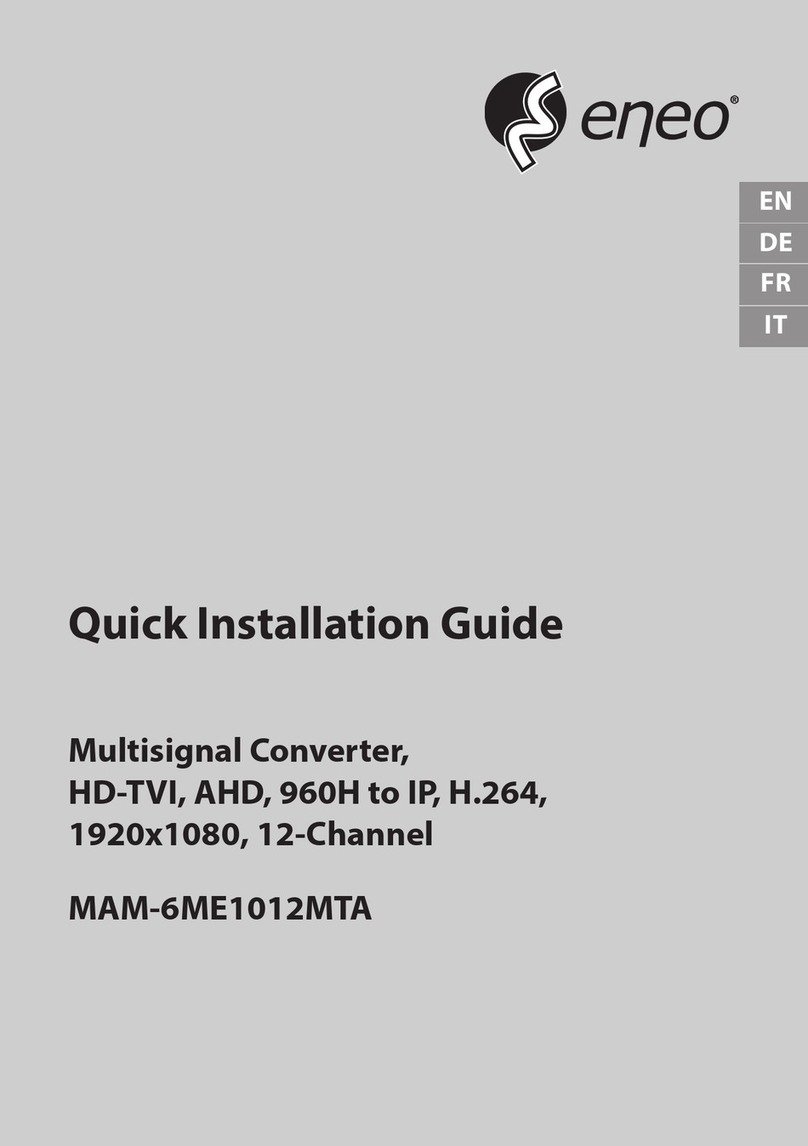
Eneo
Eneo MAM-6ME1012MTA Quick installation guide
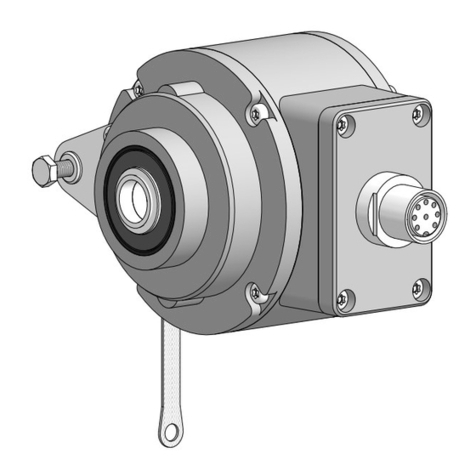
Baumer
Baumer HUBNER BERLIN HOG 10 Mounting and operating instructions
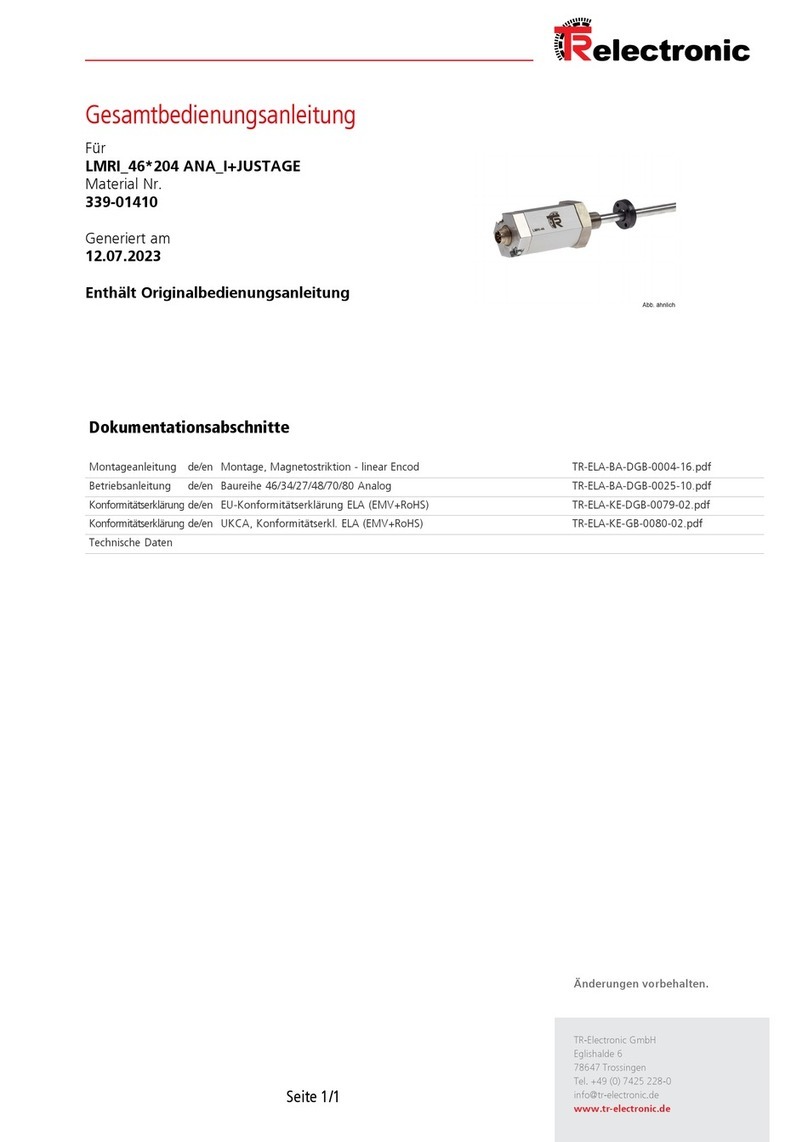
TR-Electronic
TR-Electronic LMRI-46-204 ANA-I+JUSTAGE manual
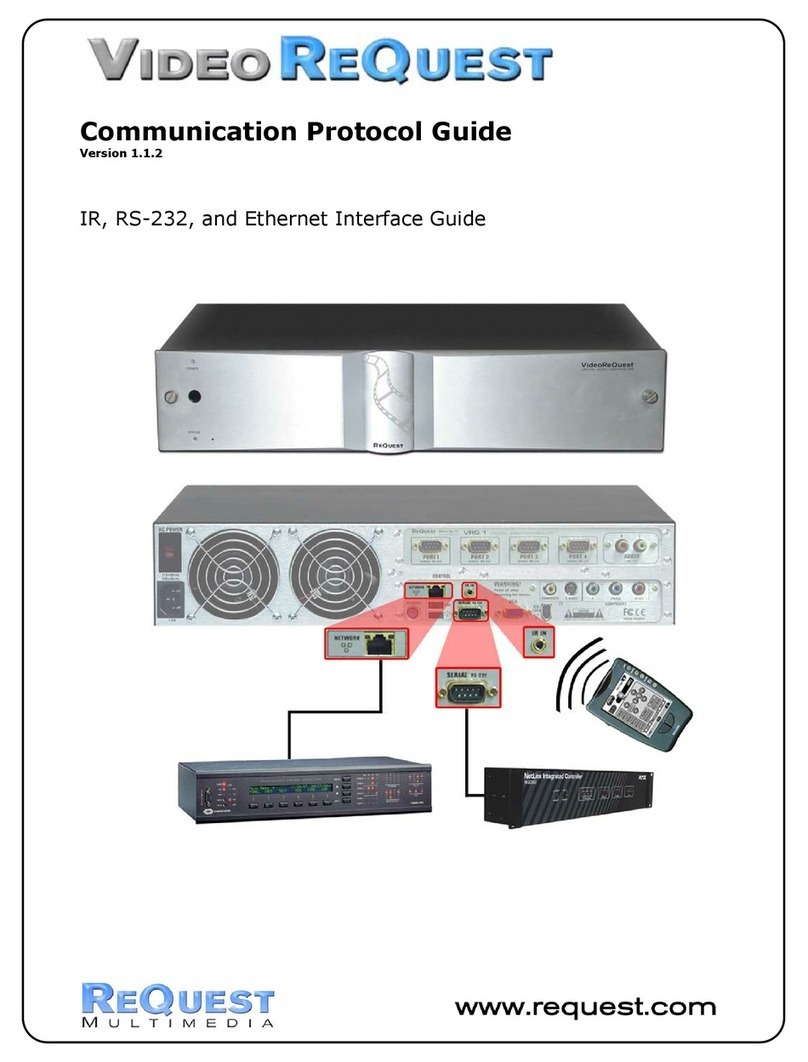
ReQuest Multimedia
ReQuest Multimedia VideoReQuest Protocol guide
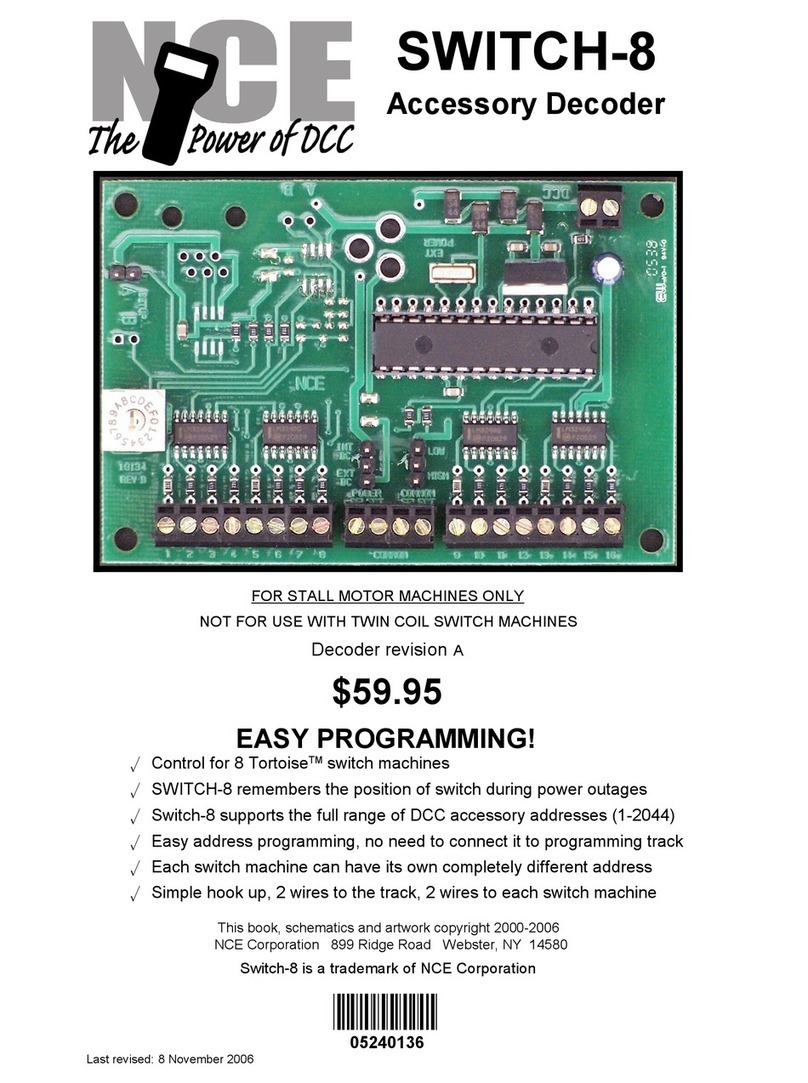
NCE
NCE SWITCH-8 manual

HEIDENHAIN
HEIDENHAIN LIF 481R Mounting instructions
